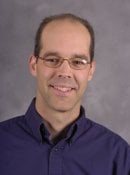 This week’s Dean’s Teaching Showcase recipient is Raymond Shaw from the Department of Physics, winner of the 2016 Michigan Tech Research Award. Shaw was selected by College of Sciences and Arts Dean Bruce Seely precisely because his efforts in the classroom forcefully demonstrate the unity of teaching and research and signal no necessary tension exists between these two core faculty responsibilities.
This week’s Dean’s Teaching Showcase recipient is Raymond Shaw from the Department of Physics, winner of the 2016 Michigan Tech Research Award. Shaw was selected by College of Sciences and Arts Dean Bruce Seely precisely because his efforts in the classroom forcefully demonstrate the unity of teaching and research and signal no necessary tension exists between these two core faculty responsibilities.
Seely says “That past fall, the Physics Department honored Ray for the Research Award in the manner it had recognized several other research award recipients — assigning them to teach a large lecture class. In Ray’s case, this was PH 2200, which covered electricity and magnetism for 390 students. He discovered large classes requires ‘one part professor and two parts theater director.’
“Fortunately, he enjoyed significant assistance from a demo crew that prepared attention-grabbing experiments suitable for classroom use, a dedicated assistant who managed iClicker content and online homework systems, the office staff that printed and organized 400 exam booklets every few weeks, and the physics learning center coaches who assisted students with homework and exams.
“At the end of the term, student evaluations ranked the class at 4.36 on the seven dimensions reported on the evaluation form. This is a very good score for a large introductory class.
“Ray identified several keys to this success, including support from Physics faculty, John Jaszczak, Wil Slough, and Bob Weidman, with extensive experience in large-lecture sections, who shared lecture materials and staging tips, and provided occasional pep talks. In addition, help from the testing center and IT staff members further confirmed that such courses are taught by a team, not just a professor.
“When asked about his contributions to making this class work, Ray noted that because big classes can seem impersonal, he ‘took it as a challenge to let my students get to know me as a person.’
“He spiced up lectures with personal anecdotes related to the course, like his rapidly-flashing blinker (RC time constants) or electromagnetic phenomena in his research. Other times he used more random elements related to life in general. He once asked students to provide iClicker responses on possible ways of disciplining his son for breaking the TV. (Corporal punishment won, but he did not take that advice) His point — students respond when taught by faculty who are real people and who care about them. As one student commented, ‘Every class was enjoyable due to the somewhat ‘nerdy’ humor followed by funny references to his son (absolutely hysterical).’
“But perhaps as important was Ray’s enthusiasm for the class. Students clearly recognized his passion and excitement about physics. One student said, ‘Your enthusiasm for Physics is inspiring. It makes the lectures much more enjoyable.’ Another added, ‘Your enthusiasm was great. You were always passionate and in a good mood.’
“This might not seem like rocket science, but teaching seems to work better in environments where faculty exhibit their enthusiasm about their field and show how they care about students and their learning.”
Shaw will be recognized at an end-of-term luncheon with 11 other showcase members, and is now eligible for one of three new teaching awards to be given by the William G. Jackson Center for Teaching and Learning this summer recognizing introductory or large class teaching, innovative or outside the classroom teaching methods, or work in curriculum and assessment.
by Michael Meyer, Director, William G. Jackson Center for Teaching and Learning